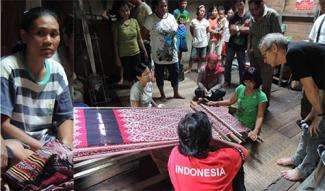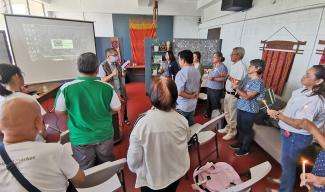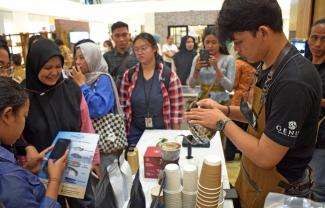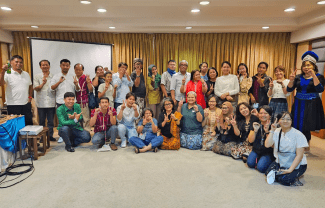She was a mild mannered woman with a sweet smile and she never got tired of our questions. She was a great cook and over two days we got to know her.
10 representatives from the Ecosystem Alliance Indonesia descended on her home in Baning Pendek, Sintang, West Kalimantan last March 12-13, 2013. She asked us to call her Linda.
She had come here to the land of the Dayak Desa years ago to marry her husband, a Dayak Desa, Lipan. She was fortunate enough to have attended a trade school while growing up, her trade was “catering†and we all benefitted from the wonderful food she served from fresh bamboo shoots to a tasty chicken liver dish mixed with tofu.
But her new found hobby and passion was weaving. She said if she could go to the trade school all over again, she would take up sewing instead of catering.
She had learned the trade of the Dayak Desa women to weave the tenun ikat only 6 years ago. Though the process can take months with the intricate steps involving knotting, dyeing, pounding and weaving, to make one piece of cloth, Linda persevered because she knew she could earn additional money to cover the family's needs. She knew that the Dayak tradition of weaving would also live on.
She said they were only 10 women in the 40 households of Baning Pendek that still practiced the weaving tradition. When asked why she said with a smile that “It is because my husband is able to help me with the cooking and other housework if I have orders for weavingâ€.
Tradition and culture are not as evident in Baning Pendek. Not like the neighboring village Ensaid Panjang which still boasts of a long house that has 93 weavers! But the efforts of Linda and other women are keeping the tradition going. Now Linda's young daughter also helps in the knotting of the cloth before it is dyed. Soon she will be weaving too!
Linda also showed us the group's natural dye nursery. It was planted 3 years ago and in two years they will be able to source their own natural dye without having to purchase it from outside. Currently most of the woven cloth is made with synthetic dyes. Linda knows natural dyed cloth fetches a higher price. Linda's cooperative, Jasa Menenun Mandiri (JMM) assisted Linda and 10 other women in Baning Pendek with the planting of the plant mengkudu. Mengkudu delivers the color red. It is becoming scarce in Banging Pendek with the conversion of remaining forest into agriculture.
In the evening we spoke with more men and women in the community. They feared that too much forest was converted to agriculture. There wasn't enough forest to obtain wood to build homes even. This is why the community agreed to dedicate part of their village as a protected forest to make sure they protect the water source as well. They are undergoing planting of hardwood species to address this concern.
In parallel, the community is very concerned about the conversion of Dayak lands around Baning Pendek into oil palm plantations. They have seen no benefit to communities in surrounding areas. The trucks of the company are also ruining the roads and they are not interested to fix any of them. The neighboring village just stopped 31 oil palm trucks and demanded for road repair.
Linda's Dayak brothers and sisters have a resolve to keep oil palm OUT of their area. The spirit of solidarity and brotherhood is still alive for even without much assistance from the local government, they are able to build their own church through communal work.
It seems, though the world in the small village of Baning Pendek is changing, Linda and her fellow Dayak, have it better off than in other villages. They still own their lands. They keep one hectare at least to feed their families and the proceeds of the hectare goes to providing schooling for their children. Linda's gardens with rubber, sago, pepper, mengkudu, paddy also shows how she is experimenting and innovating in changing times. And if ever they are in a tight spot, Linda and other women members of the community have JMM where they can borrow money. There is access to other credit unions as well.
Meanwhile, we benefited from Linda's sharing, her hospitality, her good cooking. Their ikat weaving production is still on a small scale and they are still struggling with their production, but the fact that it contributes to maintaining the weaving tradition, to re-greening the land (with natural dye planting) and to income (one woman makes close to USD 65 / month just from woven cloths which is 55% of what they make per month on rubber harvesting!), it is an important part of their livelihood and their culture. It was our simple learning from our short visit.




